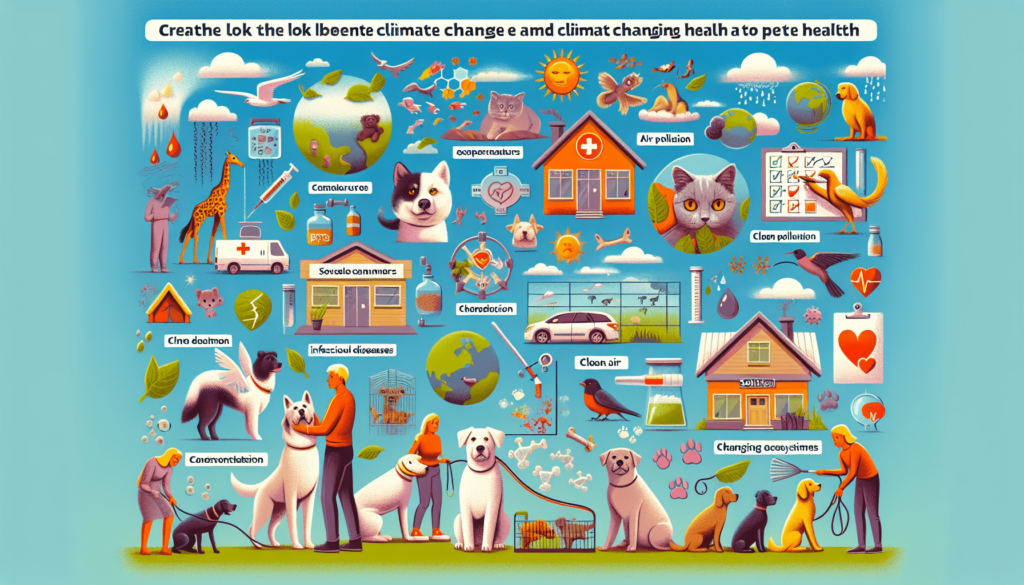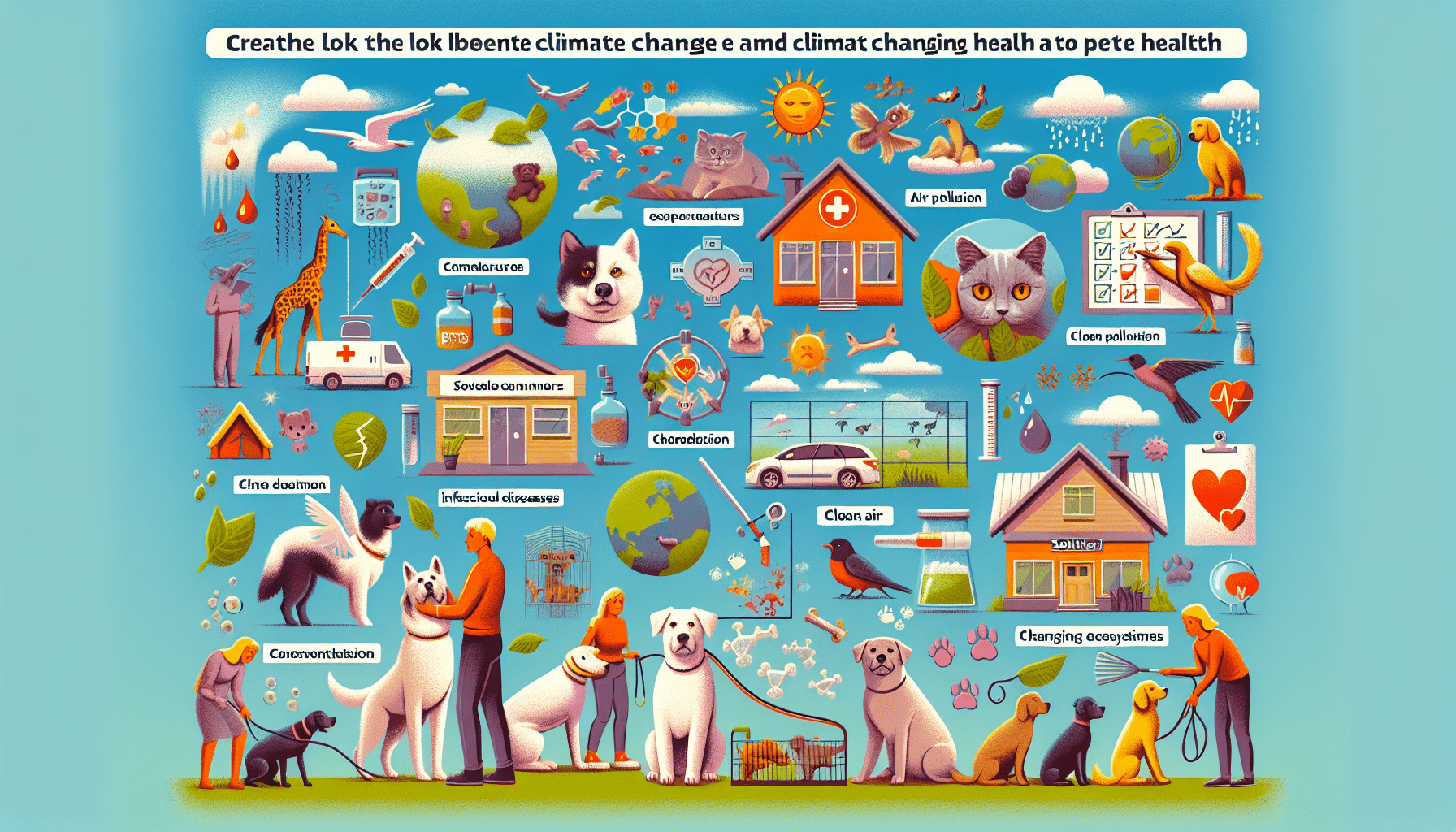Pets are cherished members of our families, offering unconditional love and companionship. However, as our planet continues to experience the effects of climate change, it is important to recognize the significant impact this has on our furry friends’ health. From increased heat waves to worsening air quality, the article explores how climate change is affecting various aspects of pet health, emphasizing the importance of proactive measures to ensure their well-being. Understanding these potential risks and learning how to mitigate them is crucial in safeguarding the health and happiness of our beloved pets.
Extreme Temperatures
Heatstroke
Climate change can lead to an increase in extreme temperatures, putting pets at a higher risk of heatstroke. As temperatures soar, especially during heatwaves, pets can struggle to regulate their body temperatures, making them susceptible to overheating. Heatstroke occurs when a pet’s body temperature exceeds its normal range, and it can have severe consequences, including organ damage and even death.
To prevent heatstroke, it’s crucial to keep your pets cool and hydrated. Provide them with access to shade and fresh water at all times. Avoid leaving pets in hot cars, as the temperature inside a vehicle can rise rapidly and become deadly within minutes. If your pet shows signs of heatstroke, such as excessive panting, drooling, rapid breathing, or weakness, seek veterinary care immediately.
Hypothermia
On the other end of the temperature spectrum, climate change can also lead to colder and more extreme winters, increasing the risk of hypothermia in pets. Hypothermia occurs when an animal’s body loses heat faster than it can produce, resulting in a dangerously low body temperature. It can be life-threatening, causing shivering, lethargy, pale gums, and even cardiac arrest in severe cases.
Protect your pets from hypothermia by providing them with warm shelter and bedding during colder months. When taking them outside for walks, consider using pet sweaters or coats to keep them cozy. If you suspect your pet is experiencing hypothermia, warm them slowly by wrapping them in dry blankets and seek immediate veterinary attention.
Vector-Borne Diseases
Increased Risk of Mosquito-Borne Illnesses
Climate change creates favorable conditions for the proliferation of mosquitoes, increasing the risk of mosquito-borne illnesses in both humans and pets. Diseases such as heartworm, West Nile virus, and various types of encephalitis can be transmitted to pets through mosquito bites. These diseases can lead to severe health complications and, in some cases, even death.
To protect your pets, ensure they are on a regular preventive medication for heartworm and other mosquito-borne diseases, as recommended by your veterinarian. Minimize exposure to mosquitoes by avoiding outdoor activities during peak mosquito activity hours and by keeping your yard clear of standing water, which serves as breeding grounds for these pesky insects.
Spread of Tick-Borne Diseases
Climate change also contributes to the spread of tick populations, thereby increasing the prevalence of tick-borne diseases. Ticks, carriers of diseases like Lyme disease, can latch onto pets during outdoor adventures and transmit harmful pathogens into their bloodstream. These diseases can cause long-term health issues for pets, including joint pain, fever, and fatigue.
Regularly check your pets for ticks after spending time outside, especially in wooded areas or tall grass. Use tick preventives as recommended by your veterinarian and consider options such as tick collars or spot-on treatments. Prompt removal of ticks is essential to reduce the risk of disease transmission, so ensure you have the proper tools and know the correct removal technique.

Allergies and Respiratory Issues
Higher Pollen Counts and Allergens
Climate change can significantly impact pollen counts and allergen levels, making pets more susceptible to allergies and respiratory issues. Increased carbon dioxide levels in the atmosphere can lead to enhanced plant growth and higher pollen production. Pets, like humans, can suffer from seasonal allergies, experiencing symptoms such as itching, sneezing, watery eyes, and skin irritations.
Consult with your veterinarian if you suspect that your pet may have allergies. They can determine the specific allergens affecting your pet and recommend appropriate treatment options, including antihistamines or allergy shots. Regular grooming, frequent bathing, and keeping your pet’s living environment clean can also help minimize exposure to allergens.
Worsening Air Quality
Climate change can also worsen air quality, which can have detrimental effects on pet health. Increased air pollution, including higher levels of particulate matter, ozone, and smog, can contribute to respiratory problems in pets, especially those with pre-existing conditions such as asthma or bronchitis.
Keep your pet indoors during periods of poor air quality, such as days with high pollution index or during wildfires when the air is filled with smoke. Use air purifiers indoors to reduce the levels of airborne pollutants. If your pet already has a respiratory condition, work closely with your veterinarian to manage their symptoms and ensure they are receiving necessary medications or treatments.
Water Contamination
Toxic Algae Blooms in Water Sources
Climate change can lead to an increase in toxic algae blooms in bodies of water, including ponds, lakes, and even coastal areas. These harmful algal blooms produce toxins that can pose significant health risks to pets if ingested. Pets may be exposed to these toxins by drinking contaminated water or even through direct contact with their skin.
To protect your pet from toxic algae blooms, avoid letting them swim or drink from bodies of water with visible algae or discoloration. Familiarize yourself with the signs of toxic algae exposure, such as vomiting, diarrhea, seizures, or difficulty breathing, and seek veterinary assistance promptly if you suspect your pet has been exposed.
Increased Chemical Runoff
Climate change can also contribute to increased chemical runoff into water sources, which can adversely affect pet health. Excess rainfall and flooding can wash away agricultural and industrial pollutants, contaminating rivers, streams, and groundwater. These contaminants can include pesticides, fertilizers, and heavy metals, posing a risk to both drinking water and aquatic ecosystems.
Consider providing your pet with filtered or bottled water to minimize their exposure to potentially contaminated water sources. Be cautious when allowing your pet to drink from outdoor water sources, such as puddles or streams, as these may contain harmful substances. If you live in an area prone to water contamination, contact your local authorities or utilities to inquire about the safety of your tap water and potential precautions to take.

Food Availability and Quality
Crop Failures and Changing Nutritional Value
Climate change can have severe implications for food availability and quality, impacting both human and animal food production. Alterations to temperature and precipitation patterns can lead to crop failures and changes in soil conditions, affecting the growth and nutritional value of crops that are essential in pet food production.
As a pet owner, stay informed about potential disruptions in the supply chain or recalls related to pet food. Consider consulting with your veterinarian or a veterinary nutritionist to ensure your pet’s dietary needs are met, especially during times of food scarcity or when there are concerns about the quality of available pet food. Supplementing their diet with fresh, nutrient-rich food can also help ensure they receive necessary nutrients.
Contaminated Pet Food
Extreme weather events, such as floods or hurricanes, caused or intensified by climate change, can lead to disruptions in pet food manufacturing, transportation, and storage. These events can result in contaminated pet food, posing health risks to pets who consume it.
To minimize the risk of contaminated pet food, store it properly in a cool, dry place, and check for any recalls or warnings. If you suspect your pet has consumed contaminated food and exhibits symptoms such as vomiting, diarrhea, or lethargy, contact your veterinarian immediately for guidance on next steps.
Mental Health
Anxiety and Stress in Pets
Changes in climate patterns and the occurrence of extreme weather events can have a significant impact on pet mental health. Pets, like humans, can experience anxiety and stress when faced with unpredictable and uncomfortable conditions, such as prolonged heatwaves, severe storms, or displacement due to natural disasters.
To mitigate anxiety and stress in pets, create a safe and comfortable environment for them during extreme weather events. Provide them with a calm and secure space indoors, away from loud noises or excessive heat. Consider using tools like anxiety wraps or pheromone diffusers to help soothe their nerves. Regular exercise, mental stimulation, and maintaining daily routines can also help alleviate anxiety in pets.
Behavioral Changes
In response to changing environments, pets may exhibit behavioral changes due to climate change-related factors. These changes can range from increased aggression or fearfulness to excessive vocalization or destructiveness. Environmental stressors, such as altered temperatures, disrupted routines, or unfamiliar surroundings, can contribute to these behavioral shifts.
Maintain consistency and stability in your pet’s daily routine as much as possible, to minimize the impact of behavioral changes. Engage in positive reinforcement training techniques to address any concerning behaviors and seek guidance from a professional animal behaviorist if needed. Providing pets with appropriate mental stimulation, such as interactive toys and puzzles, can also help divert their attention and alleviate stress.
Natural Disasters
Evacuations and Displacement
Climate change can lead to an increase in the frequency and intensity of natural disasters, such as hurricanes, wildfires, or flooding. These events often necessitate evacuations and displacements, posing challenges for pet owners in ensuring their pets’ safety and well-being.
Prepare an emergency plan for your pets that includes identification tags and microchipping, as well as assembling a disaster supply kit with necessary provisions such as food, water, medications, and comfort items for your pets. Familiarize yourself with pet-friendly evacuation shelters or hotels in your area and have a designated caregiver or a boarding facility in case you are unable to care for your pet during an emergency.
Injuries and Trauma
Natural disasters can result in injuries and trauma for pets, just like they do for humans. Pets may find themselves in dangerous situations during extreme weather events, such as being trapped under debris or exposed to harmful environmental conditions. Injuries sustained during these events can range from minor cuts and bruises to more severe trauma requiring immediate medical attention.
Ensure that your pets are wearing identification tags or have microchips registered with updated contact information, as this can increase their chances of being reunited with you if they become separated during a disaster. Immediately after a disaster, assess your pet for any possible injuries and contact your veterinarian for guidance on providing appropriate medical care or accessing veterinary services in your area.
Loss of Habitat
Impact on Wildlife
Climate change and the associated destruction of habitats have a profound impact on wildlife populations. This disruption affects not only the survival of various species but also alters ecosystems as a whole. The loss of habitat can lead to increased competition for resources, changes in predator-prey relationships, and potential shifts in the prevalence of certain diseases.
As pets are part of the natural ecosystem, these changes can indirectly affect their well-being. It is important to be mindful of the environmental impact of pet ownership and take steps to minimize harm to wildlife. Keep cats indoors or supervise their outdoor activities to prevent hunting of birds or other small animals. Additionally, choose pet-friendly products that are environmentally sustainable and opt for responsible waste disposal methods.
Reduced Biodiversity
The loss of habitat due to climate change can also result in reduced biodiversity, affecting the overall health and resilience of ecosystems. Biodiversity plays a crucial role in maintaining ecological balance and ensuring a range of resources and services that are essential for both humans and animals.
By supporting conservation efforts and advocating for environmental policies aimed at preserving biodiversity, pet owners can contribute to the protection of ecosystems and the well-being of their pets. Engage in responsible pet ownership practices that prioritize the planet’s health, such as using eco-friendly pet products and reducing waste.
Drought and Water Scarcity
Dehydration and Heat Stress
Drought conditions associated with climate change can lead to water scarcity, which poses a risk to pet health. Dehydration and heat stress can occur when pets do not have access to adequate amounts of clean water and suffer from prolonged exposure to high temperatures.
Ensure that your pets have access to fresh water at all times, especially during dry and hot periods. Consider installing automatic water dispensers or multiple water stations throughout your home and yard. Additionally, avoid strenuous activities during peak heat hours and provide shaded areas outdoors for your pets to rest and cool down.
Reduced Access to Clean Water
Climate change can disrupt water sources, affecting the quality and availability of clean drinking water for both humans and animals. Water contaminated with pollutants, chemicals, or toxins can have severe health implications for pets if ingested.
Regularly check the quality of your pet’s drinking water, particularly if you rely on private wells or other non-municipal sources. Test for potential contaminants and invest in water purification systems if necessary. If you notice any changes in your pet’s behavior or health that could be linked to water consumption, consult with your veterinarian to assess possible water-related issues.
Pesticide Exposure
Negative Effects on Pet Health
Climate change can influence the prevalence and distribution of pests and the subsequent use of pesticides to control their populations. Increased pesticide usage can have adverse effects on pet health, as pets may come into contact with or ingest these toxic substances.
To minimize risks associated with pesticide exposure, avoid using pesticides in or around areas where your pets spend time, such as lawns or gardens. If you must use pesticides, follow the instructions carefully and keep your pets away from treated areas until the recommended waiting period has passed. Regularly groom your pets to remove any potential pesticide residue from their fur or paws.
Contaminated Soil and Plants
The use of pesticides and the consequent runoff into the soil can result in contamination of plants and vegetation. Plants exposed to pesticides may carry residues that can be harmful to pets if ingested, either directly or through secondary consumption.
Be cautious when allowing your pets to graze on plants or grass in areas where pesticides may have been used. Consider creating a designated pet-friendly area in your yard, where you can grow pesticide-free plants or provide them with safe alternatives for grazing, such as pet-friendly grass or edible herbs. Regularly inspect your yard for any signs of potential plant contamination or toxicity, such as wilting, discoloration, or abnormal growth.
With climate change becoming an increasingly urgent issue, understanding the impact it has on pet health is essential for every pet owner. By recognizing the risks associated with extreme temperatures, vector-borne diseases, allergies, water contamination, food availability, mental health, natural disasters, habitat loss, drought, and pesticide exposure, pet owners can take proactive measures to protect and safeguard their beloved companions. Remember, by being a responsible and environmentally conscious pet owner, you can make a positive difference in the lives of your pets and contribute to a healthier planet for all.

